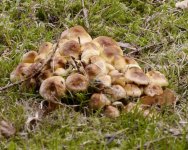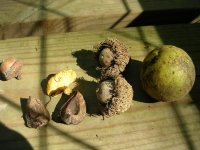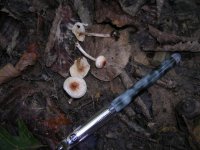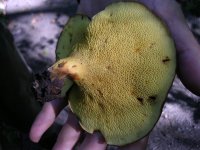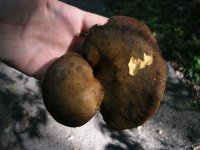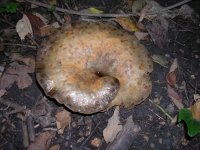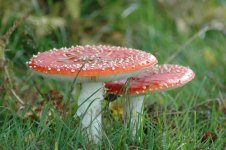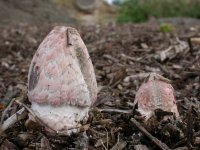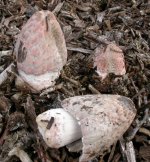-
Welcome to BirdForum, the internet's largest birding community with thousands of members from all over the world. The forums are dedicated to wild birds, birding, binoculars and equipment and all that goes with it.
Please register for an account to take part in the discussions in the forum, post your pictures in the gallery and more.
You are using an out of date browser. It may not display this or other websites correctly.
You should upgrade or use an alternative browser.
You should upgrade or use an alternative browser.
Any fungi about? (8 Viewers)
- Thread starter Leif
- Start date
More options
Who Replied?Larry Lade
Moderator
Sorry about #6 photo, actually it is quite a handsome "coral mushroom". Its delicate shape is rather obscured due to the "out of focus" or "shake of the photographer"!
#8 is a Golden Chanterelle, Cantharellus cibarius. I took a tiny bite of it, to get a feel for the taste and texture. My son suggested that I not swallow it, so I did not. I am quite the neophyte when it comes to mycology, as are many people here in the states. While "googling" in the mycological arena, I chanced upon a statement to the effect that in Europe people have a much greater interest in mushrooms and have been studying, collecting and eating them for many years. Here in the states, for the most part, this interest in "toadstools" has generally been rather low-keyed. For example, here in Missouri I found that we have a Mycology Club which only came into existence 15 years ago. I think that in the future I will be more aware of possibility of finding some of the various mushroom types when I am afield!
I mentioned morels and oysters in an above post, but I was aware in the past of "puffballs", "inkies" and what I mistakenly called "toadstools". I have never eaten other than the morels and osyters of the wild mushrooms in the past.
Here are a couple more photos from that day my son and I were out looking for mushrooms (and birds). #9 photo shows the chanterelle, small acorn, acorns of the "overcup oak", outer hull quarters of the hickory nut and a Black Walnut (which is still in the green outer husk.
Do you have morels in Britian?
#8 is a Golden Chanterelle, Cantharellus cibarius. I took a tiny bite of it, to get a feel for the taste and texture. My son suggested that I not swallow it, so I did not. I am quite the neophyte when it comes to mycology, as are many people here in the states. While "googling" in the mycological arena, I chanced upon a statement to the effect that in Europe people have a much greater interest in mushrooms and have been studying, collecting and eating them for many years. Here in the states, for the most part, this interest in "toadstools" has generally been rather low-keyed. For example, here in Missouri I found that we have a Mycology Club which only came into existence 15 years ago. I think that in the future I will be more aware of possibility of finding some of the various mushroom types when I am afield!
I mentioned morels and oysters in an above post, but I was aware in the past of "puffballs", "inkies" and what I mistakenly called "toadstools". I have never eaten other than the morels and osyters of the wild mushrooms in the past.
Here are a couple more photos from that day my son and I were out looking for mushrooms (and birds). #9 photo shows the chanterelle, small acorn, acorns of the "overcup oak", outer hull quarters of the hickory nut and a Black Walnut (which is still in the green outer husk.
Do you have morels in Britian?
Attachments
Last edited:
Larry Lade
Moderator
Larry Lade said:Leif, here are some more shots of the mushroom type shown in #1 and #7 photos.
Larry: Have you tried the "Roger's Mushrooms" web site? He is the author of probably the best general guide to macro-fungi. I don't even know what genus yours might be in. Leif
Larry Lade said:Sorry about #6 photo, actually it is quite a handsome "coral mushroom". Its delicate shape is rather obscured due to the "out of focus" or "shake of the photographer"!
#8 is a Golden Chanterelle, Cantharellus cibarius. I took a tiny bite of it, to get a feel for the taste and texture. My son suggested that I not swallow it, so I did not. I am quite the neophyte when it comes to mycology, as are many people here in the states. While "googling" in the mycological arena, I chanced upon a statement to the effect that in Europe people have a much greater interest in mushrooms and have been studying, collecting and eating them for many years. Here in the states, for the most part, this interest in "toadstools" has generally been rather low-keyed. For example, here in Missouri I found that we have a Mycology Club which only came into existence 15 years ago. I think that in the future I will be more aware of possibility of finding some of the various mushroom types when I am afield!
I mentioned morels and oysters in an above post, but I was aware in the past of "puffballs", "inkies" and what I mistakenly called "toadstools". I have never eaten other than the morels and osyters of the wild mushrooms in the past.
Here are a couple more photos from that day my son and I were out looking for mushrooms (and birds). #9 photo shows the chanterelle, small acorn, acorns of the "overcup oak", outer hull quarters of the hickory nut and a Black Walnut (which is still in the green outer husk.
Do you have morels in Britian?
10) The little white and brown ones are Lepiotas. Thet might be Lepiota cristata, the Stinking Lepiota, but I wouldn't want to say from a photo, and no other details such as spore size, habitat and so on. As the name suggests, L. cristata it has an unpleasant smell, though most Lepiota do seem to have a nasty whiff about them.
We in the UK are somewhat ambivalent in our attitude to Europe. Sometimes we are a separate nation, sometimes we are Europeans. That dichotomy is mycological as well as geo-political. In most of Europe wild mushrooms are greatly prized, especially in Russia and Italy. In the UK they were largely ignored until recently, and even now most people do not know what to pick, so they do not take the risk. When I go mushroom picking, most people I meet speak a language other than English, such as Polish, and struggle to converse in English. Last year I discovered on two separate occasions that a German and a Polish family had found 'my' Chanterelle patch.
Yes we do have Morels in Britain. The Common Morel is rare, and occurs on chalk soil in Southern England, and elsewhere. The Black Morel is rare, more northern, and occurs with Pine, and also on wood chips. Both kinds make excellent eating. But we also have the deadly poisonous False Morel, which is not dissimilar. They're easy to tell apart if you know what you are doing, but easy to confuse otherwise. I am told that Morels are much more common in your country.
Leif
Larry Lade
Moderator
In the spring of the year, beginning in April, a large contingent of the midwestern states population go out "mushrooming". It is quite an annual event! There is a lot of interest in and publication about (in magazines, newspapers, on TV and radio) the search for the morels. The morel is quite common, but takes some looking! It is the one species which people here go out and look for. Your comment about "your" chanterelle patch is not dissimilar to peoples' "morel patches" over here. The location of one's patch is a highly guarded secret.
KarltheBatman
Member
Fungi Foto Competition
Just a quick point of information.
22nd - 30th October is the Herefordshire Festival of Fungi.
Check out www.herefordshire-fungi.org.uk for full info.
But some may want to enter the foto competition as there are some cracking fotos being shown on this site.
But pull your finger out, entries have to be in by Friday 7th October!!
:scribe:
Just a quick point of information.
22nd - 30th October is the Herefordshire Festival of Fungi.
Check out www.herefordshire-fungi.org.uk for full info.
But some may want to enter the foto competition as there are some cracking fotos being shown on this site.
But pull your finger out, entries have to be in by Friday 7th October!!
:scribe:
Larry Lade
Moderator
Hi Leif, I finally got word back from my son who is in New York. He has informed me that the mushroom in photo #1 and #7 is Boletinellus merulioides (Ash-tree Bolete). There are additional photos of this species in my post #43 above. I have not as yet checked out this species in my general reference books or on the internet to compare with the species which my son suggests.
He has not met with members of his mycological group for more IDs of the other mushrooms which I posted.
Good Mushrooming! Are you also a birder? I have not checked out all of your posts, I suppose I should do that and find out what your other interests are. Cheers!
He has not met with members of his mycological group for more IDs of the other mushrooms which I posted.
Good Mushrooming! Are you also a birder? I have not checked out all of your posts, I suppose I should do that and find out what your other interests are. Cheers!
Larry Lade
Moderator
Larry Lade
Moderator
Snapper, those are very attractive mushrooms. Off hand I do not know what kind they are either, but Leif should be along shortly and I imagine he will be able to identify them for you.
Silver
Registered Sane
snapper said:Hi all found this Fungi in a field next to half a dozen birch trees at deep hayes country park in the Staffordshire Moorlands yesterday but have not got a clue what it is any help please. Regards Snapper.
Classic material!
It is Fly Agaric, Amanita muscaria.
It forms mutually beneficial associations with tree-roots, most commonly with birch, but also with pine, beech, hornbeam and a variety of other trees.
Also known as an hallucinogen and with a history of use in various ancient ceremonies, though the manner of its use I'll maybe not go into. Warning - it also contains a number of other toxins and while it probably won't kill anyone if eaten in normal amounts, it can cause some very nasty symptoms. It shows a lot of variation and this variation no doubt applies to chemical constituents too.
Alan
Larry Lade
Moderator
Photo #3 in my post #35 in this thread has been identified as Suillus americanus by a mushroom expert in New York (a friend of our son). These waxy yellow mushrooms were found in an area where there were some White Pine trees.
Larry Lade said:Photo #3 in my post #35 in this thread has been identified as Suillus americanus by a mushroom expert in New York (a friend of our son). These waxy yellow mushrooms were found in an area where there were some White Pine trees.
At least I got the correct genus!
I believe that Roger Phillips has produced a nice guide to US fungi. He also has a web site.
Leif
Larry Lade
Moderator
Yes, Leif, you were right on target with Suillus!
And, according to my son's friend, this S. americanus only occurs around White Pine. (There were White Pine in the immediate area.)
And, according to my son's friend, this S. americanus only occurs around White Pine. (There were White Pine in the immediate area.)
Last edited:
Coprinus identification please
A few more fungi appearing locally.
This Coprinus has me baffled. Growing on a wood chip pile under an old (dead) standing oak in open parkland. The pink scales were distinctive and the caps quite squat and short. Fungus about 6-8 cm in height. No ring on stem. Nothing obvious in my books?
Any suggestions welcome.
Fungbot
A few more fungi appearing locally.
This Coprinus has me baffled. Growing on a wood chip pile under an old (dead) standing oak in open parkland. The pink scales were distinctive and the caps quite squat and short. Fungus about 6-8 cm in height. No ring on stem. Nothing obvious in my books?
Any suggestions welcome.
Fungbot
Attachments
Fungbot said:A few more fungi appearing locally.
This Coprinus has me baffled. Growing on a wood chip pile under an old (dead) standing oak in open parkland. The pink scales were distinctive and the caps quite squat and short. Fungus about 6-8 cm in height. No ring on stem. Nothing obvious in my books?
Any suggestions welcome.
Fungbot
I can't say that I have a clue though I am curious as to why you think it is a Coprinus.
As an aside, do you have much in the way of fungi in your area? Here in Berkshire there has been very little. I visited Hatfield Forest at the weekend and it too was completely free of fungi. Odd. The exception is the grasslands in Berkshire and Surrey: plenty of Entoloma, Hygrocybe etc. Leif
Leif said:I can't say that I have a clue though I am curious as to why you think it is a Coprinus.
As an aside, do you have much in the way of fungi in your area? Here in Berkshire there has been very little. I visited Hatfield Forest at the weekend and it too was completely free of fungi. Odd. The exception is the grasslands in Berkshire and Surrey: plenty of Entoloma, Hygrocybe etc. Leif
Hi Leif
Another 'Coprinus' image added, perhaps a bit clearer. I thought the 'jizz' put it into Coprinus family. Still open to offers for a name!
Fungi are in short supply locally, most of the Ancient Semi-Natural woodland has been poor. Parkland and grasslands better but nothing like last season, few Hygrocybe and dung fungi. Flush of Macrolepiota this week so perhaps a late appearance of species if the frosts keep away.
Fungbot
Attachments
Fungbot said:Hi Leif
Another 'Coprinus' image added, perhaps a bit clearer. I thought the 'jizz' put it into Coprinus family. Still open to offers for a name!
Fungi are in short supply locally, most of the Ancient Semi-Natural woodland has been poor. Parkland and grasslands better but nothing like last season, few Hygrocybe and dung fungi. Flush of Macrolepiota this week so perhaps a late appearance of species if the frosts keep away.
Fungbot
Yes I would also plump for Coprinus. It is distinctive so I suspect the id should be easy once you find the candidate species. I didn't see anything in Vol. 4 of the Fungi of Switzerland. Leif
Silver
Registered Sane
Fungbot said:A few more fungi appearing locally.
This Coprinus has me baffled. Growing on a wood chip pile under an old (dead) standing oak in open parkland. The pink scales were distinctive and the caps quite squat and short. Fungus about 6-8 cm in height. No ring on stem. Nothing obvious in my books?
Any suggestions welcome.
Fungbot
I'm not 100% positive as it is so young, but I think it must be Coprinus romagnesianus.
A close relative of C. atramentarius, but scaly, the scales (velar remains) being pink or rust in colour.
It's an impressive fungus when mature!
Alan
Similar threads
- Replies
- 0
- Views
- 144
Users who are viewing this thread
Total: 9 (members: 0, guests: 9)




